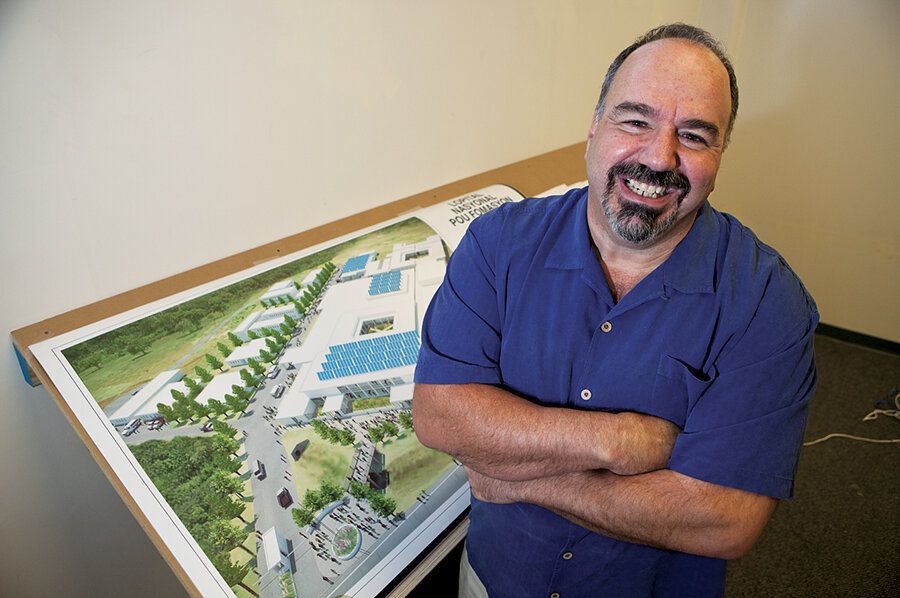Using hands-on philanthropy to bring Haiti relief
Loading...
| Beverly, Mass.
Ever since a devastating earthquake rocked Haiti a year ago, James Ansara of Essex, Mass., has been demonstrating how he's not your typical multimillionaire philanthropist.
While his peers were writing checks, Mr. Ansara was doing that – and much more. Days after the quake hit, he was up to his elbows in rubble, repairing generators with his own hands and restoring power to a desperate situation in Port-au- Prince, Haiti's capital.
He keeps going back, week after week, in a bid to bring world-class health care to the hemisphere's poorest country.
"I think it's really one in a million [donors] who are [as] personally invested" as Ansara is, says Bill Shore, executive director of Share our Strength, a Boston-based antipoverty organization with projects in Haiti. "Generally, we might be successful in getting [donors] to make a trip or two to a place like Haiti ... or New Orleans, after Katrina. But for someone to go down there on a weekly basis since January [2010, as Ansara has] is remarkable."
Ansara, a construction magnate who retired early, brings a rare combination of personal wealth, practical skills, deep experience and – perhaps rarest of all – a willingness to share in Haiti's suffering.
He needs all those qualities in his current volunteer role with Partners in Health (PIH), a nonprofit that runs 60 hospitals in 12 countries. Ansara is director of construction for PIH's Mirebalais Hospital, Haiti's largest postquake building project.
With 320 beds, Mirebalais Hospital will be Haiti's biggest, at least until the city hospital in Port-au-Prince is rebuilt, which may take years. At Mirebalais, Haitians will have access to basic health services as well as specialty surgeries never before available to them.
To open Mirebalais by November 2011, Ansara puts in 90-hour workweeks, sometimes via laptop and phone from Essex, north of Boston, where he raises four adopted teenagers with his wife, Karen.
Otherwise he's in Haiti, where he lives with an erratic water pump, routine power outages, and a nearby river that makes travel impossible after heavy rains.
Ansara doesn't have to live that way. He's plenty wealthy, even after giving away more than $18 million since he began the process of selling his business, Shawmut Construction, to his employees in 1997.
Still, he puts on no airs. He drives a 2010 Ford Focus. He arrives for a cafe interview in jeans and an untucked plaid shirt.
He puts up with Haiti's frustrations, he says, because "it's absolutely a calling for me. I believe in the social justice tenets of what Jesus taught. I come at this very much from a social justice, equity point of view. I have such an incredibly privileged life that I can never just enjoy that. I have to help – try to help – people who don't have."
Mirebalais is the largest hospital construction project in PIH's 23-year history. The facility will have features that owe their inclusion to Ansara's involvement, says Ted Constan, PIH's chief program officer. They include an easy-to-navigate environment for disabled patients and bedside oxygen stations – a first for Haiti.
"Mirebalais will have elements of infection control that we've never done before, earthquake standards that have not been seen in Haiti, and green technologies," Mr. Constan says. "All of these are things that Jim, with his career in construction management, is making possible."
Completion of the hospital will show the world that Haiti is not hopelessly dysfunctional but can accomplish great things, Mr. Shore says. "It's just one hospital, but it's going to be a very powerful symbol. I think it's going to become a huge point of pride in the Haitian nation, one that could affect a lot of other things."
Ansara grew up in a blue-collar Boston family. His father wrote fiction and drove a taxi. His mother taught school and advocated for the poor, especially children.
He attended elite schools on scholarships, but never graduated from college. His restless mind led him to master the building trades – plumbing, carpentry, and electrical work – where complex problems were always his favorites.
He founded Shawmut, and it prospered by solving tough problems in old buildings, especially on college campuses. After retiring in his early 40s, he built two lobster boats because he liked the challenge – and besides, the first one wasn't perfect.
The Ansaras have been active in philanthropic causes, largely through foundations that fund projects seeking long-term solutions to poverty.
But he needed to get his hands dirty.
"I wanted to do more than just serve on boards," Ansara says. "[Mirebalais] has given me a much bigger purpose. If we can really pull this off, it will have a tremendous impact on health care in Haiti…. This will attract people from all over Haiti because it's free care, it's a good hospital."
Ansara isn't shy about asking others to help, Shore says. He's prevailed on bootmaker Timberland to donate 300 pairs of boots for hospital construction workers.
Because of his track record, Ansara's appeals come with "a moral authority," Shore says. "When he tells people he needs something, you feel you've almost got to deliver it for him."





